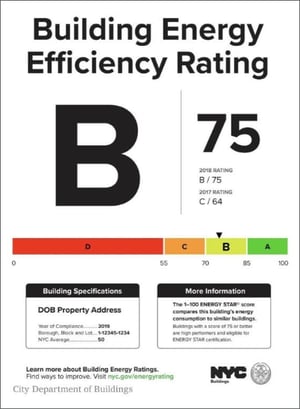Share this
2020 Ushers in Building Energy Grades in New York
by Phoenix Energy Technologies on Feb 3, 2020

New York City started their roll out of new building energy grades on January 1st this year. Commercial buildings in the city now have to display a letter grade that corresponds to an energy rating as part of the city’s ongoing commitment to lower energy usage.
Since 2009, NYC has been gathering data on energy usage on commercial buildings as part of Local Laws 84 and 87 (LL84 & LL87). In an effort to reduce greenhouse gasses and increase efficiency, LL84 would require building owners to submit yearly data reporting energy usage and water consumption. LL87 is a companion law that would require energy efficiency reports every ten years to be able to gauge usage over time. Both laws seek to make noticeable improvements to the air quality and water consumption in one of the country’s most densely populated areas.
In a nod to transparency and informing the public, all buildings in NYC over 25,000 square feet are mandated to post their energy consumption grade in a conspicuous place. The grades will be similar to what is already used in restaurants. But what do these grades mean? The breakdown of the letter grades will be as follows:
- A – score is equal to or greater than 85;
- B – score is equal to or greater than 70 but less than 85;
- C – score is equal to or greater than 55 but less than 70;
- D – score is less than 55;
- F – for buildings that didn’t submit required benchmarking information;
- N – for buildings exempted from benchmarking or not covered by the Energy Star program.
 Tenants seeking rental space for their business will now have additional data to make their decisions based on the energy rating and not just a loose monthly estimation from a real estate agent or building manager. So, the effect will be cyclical. Savvy business owners looking to get the most ROI on their office location will factor in energy costs.
Tenants seeking rental space for their business will now have additional data to make their decisions based on the energy rating and not just a loose monthly estimation from a real estate agent or building manager. So, the effect will be cyclical. Savvy business owners looking to get the most ROI on their office location will factor in energy costs.
This new information will encourage building owners to upgrade their energy systems to be as efficient as possible to attract discerning business owners, and the residents of the city will benefit from cleaner air and reduced water consumption.
According to the city government, these benchmarking laws are extensions of existing laws that move the city to a place of transparency and efficiency by holding building owners accountable for the rating of their real estate holdings. The energy grades, as well as efficiency scores, will be readily available to the public and be a part of the EPA’s Energy Star Portfolio Manager, which is available to building owners to track energy usage throughout their entire portfolio. It will also compare energy performance and consumption to that of similarly sized buildings in comparable climates.
NYC is taking a real stance on making its most prized asset, commercial real estate, as efficient as possible with the threat of low occupancy due to poor grades, as well as fines to buildings that do not post their scores. By holding building owners accountable to these new laws, city officials are enforcing one component of the Climate Mobilization Act, which was a complex package of laws geared to lowering greenhouse gasses by 40 percent by 2030.
Building owners will be given somewhat of a grace period till 2024 to clean up their act before receiving any fines or penalties. But the court of public opinion will be leading the charge as to what buildings are offering energy efficiency incentives to rent space in, versus which building owners are dragging their heels.
PhoenixET provides weekly news on building and energy management for managers in grocery, retail, theaters and any sector with energy saving goals. To receive updates, subscribe to our blog below.
Related posts
4 Common Myths of Energy Conservation in Building Management
Adaptive Energy Management Guide
Building Management Technologies Guide
Are You Managing Your Energy Spend?
Share this
- Facilities Management (91)
- Energy Management (69)
- Company News (49)
- Smart Buildings (37)
- Retail (36)
- Building Management (24)
- Building Automation Systems (21)
- Sustainability (20)
- Energy Demand Management (19)
- EEI (15)
- Adaptive Energy Management (14)
- Grocery (14)
- demand response (14)
- Artificial Intelligence (12)
- Data Integration and Visibility (10)
- HVAC IQ (9)
- COVID-19 (8)
- Customer Spotlight (8)
- Carbon Management (7)
- Setpoints and Temperatures (7)
- Equipment Maintenance (6)
- Operational Efficiency (6)
- Refrigeration Optimization (6)
- Ask Ron (5)
- Asset Manager (5)
- Finance and Procurement (5)
- IoT and Digital Transformation (5)
- Awards (4)
- Comfort (4)
- Energy & Store Development (4)
- Safety and Compliance (4)
- Demand Charge Management (3)
- Energy Management System (3)
- Lifecycle Asset Management (3)
- Premium Services (3)
- Refrigeration IQ (3)
- Automated Demand Response (2)
- ConnexFM (2)
- Customer Service (2)
- HVAC Vendor Management (2)
- Load Shedding (2)
- Technician View (2)
- AIM Act (1)
- ALD (1)
- Analytics (1)
- Data (1)
- Data Integration and Visualization (1)
- EMS (1)
- Knowledge Center (1)
- OSHA (1)
- asset management (1)
- December 2025 (1)
- November 2025 (1)
- October 2025 (2)
- September 2025 (1)
- August 2025 (3)
- July 2025 (1)
- June 2025 (1)
- May 2025 (2)
- March 2025 (2)
- February 2025 (1)
- January 2025 (2)
- December 2024 (2)
- October 2024 (1)
- September 2024 (1)
- August 2024 (2)
- June 2024 (2)
- April 2024 (2)
- March 2024 (2)
- January 2024 (1)
- December 2023 (1)
- October 2023 (2)
- September 2023 (2)
- August 2023 (2)
- July 2023 (1)
- May 2023 (2)
- April 2023 (2)
- March 2023 (3)
- February 2023 (1)
- January 2023 (1)
- December 2022 (1)
- November 2022 (2)
- October 2022 (2)
- September 2022 (1)
- May 2022 (2)
- April 2022 (1)
- March 2022 (3)
- February 2022 (2)
- January 2022 (4)
- December 2021 (2)
- November 2021 (3)
- October 2021 (1)
- September 2021 (3)
- August 2021 (4)
- July 2021 (1)
- June 2021 (2)
- May 2021 (1)
- January 2021 (2)
- December 2020 (2)
- November 2020 (2)
- October 2020 (3)
- September 2020 (4)
- August 2020 (3)
- July 2020 (2)
- June 2020 (3)
- May 2020 (3)
- April 2020 (5)
- March 2020 (5)
- February 2020 (4)
- January 2020 (4)
- December 2019 (4)
- November 2019 (3)
- October 2019 (4)
- September 2019 (5)
- August 2019 (4)
- July 2019 (4)
- May 2019 (2)
- April 2019 (3)
- February 2019 (1)
- December 2018 (1)
- November 2018 (1)
- October 2018 (3)
- September 2018 (3)
- August 2018 (3)
- July 2018 (3)
- June 2018 (3)
- May 2018 (1)
- June 2015 (1)
- March 2013 (1)
- January 2013 (1)
- December 2011 (1)
- October 2011 (1)
- September 2011 (1)


